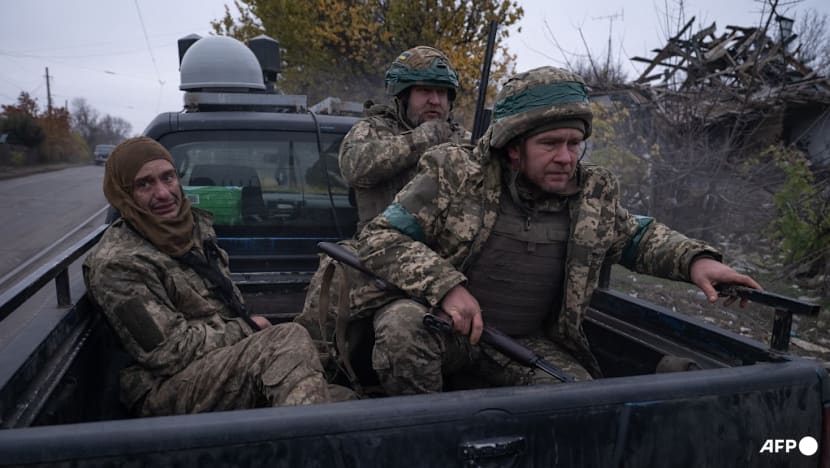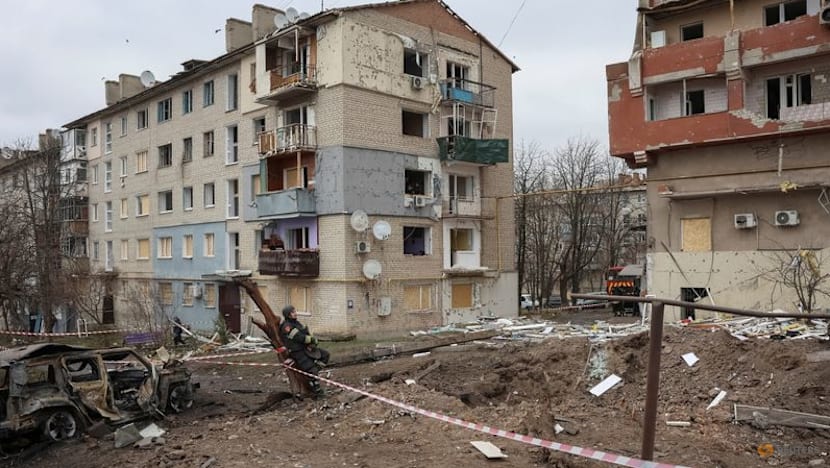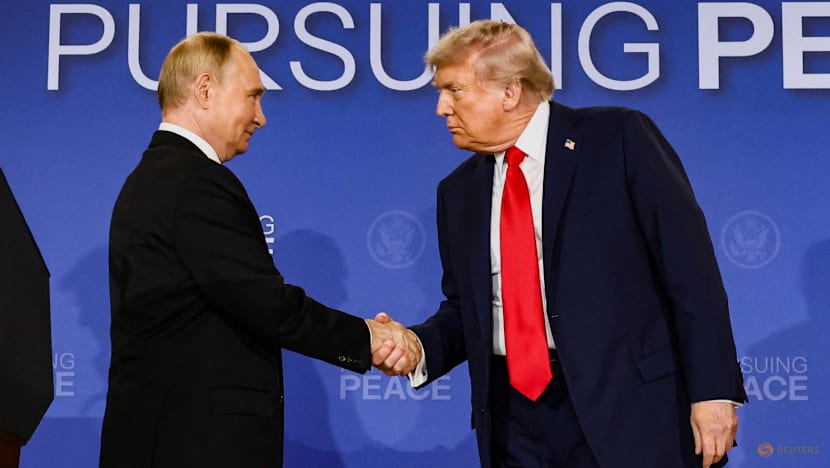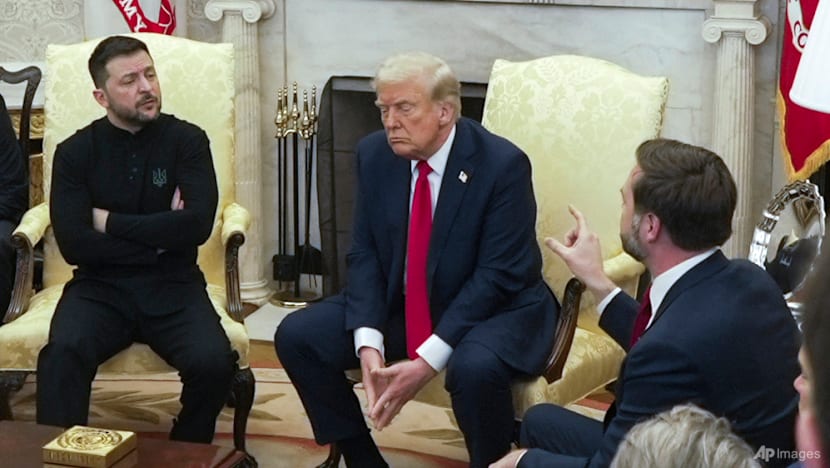What we know about the leaked US draft plan for ending Russia’s Ukraine war
Ukraine would give up a swathe of eastern territory to Russia and slash the size of its army under a sweeping 28-point peace plan backed by US President Donald Trump, according to a draft proposal.

This handout photograph, taken on Nov 11, 2025, by the press service of the 93rd Kholodnyi Yar Separate Mechanized Brigade of the Ukrainian Ground Forces shows Ukrainian servicemen evacuating a wounded soldier near the frontline city of Kostyantynivka in the Donetsk region, amid the Russian invasion of Ukraine. (Photo: Iryna Rybakova/Press service of the 93rd Separate Mechanized Brigade of the Ukrainian Ground Forces/AFP)
Ukraine would give up a swathe of eastern territory to Russia and slash the size of its army under a sweeping 28-point peace plan backed by US President Donald Trump, according to a draft proposal that has been widely leaked.
Kyiv would also pledge never to join NATO. It would not get the Western peacekeepers they have called for, although European warplanes would be stationed in Poland to protect Ukraine.
The proposal, originating from negotiations between Washington and Moscow, appeared favourable to Russia, which started the war nearly four years ago.
Here’s what we know about the leaked text and the reactions to it.
TERRITORY
Key parts of the proposal correspond to Moscow's previous demands and cross Ukraine's red lines.
These include that Ukraine would withdraw from the Lugansk and Donetsk regions, the frontline industrial belt known collectively as the Donbas, which Ukraine still partly holds.
The two regions and Crimea, which Russia annexed in 2014, "will be recognised as de facto Russian, including by the United States”, while a demilitarised zone would be created in the Donbas.
The war-torn southern regions of Kherson and Zaporizhzhia - which Russia falsely claims to have annexed - will be "frozen along the line of contact”, it said.
Russia's army occupies around a fifth of Ukraine - much of it ravaged by years of fighting.
Under the proposal, Russia would commit to making no future attacks, something the White House views as a concession. In addition, US$100 billion in frozen Russian assets would be dedicated to rebuilding Ukraine.
UKRAINE SECURITY
Ukraine had been hoping for European-led peacekeepers but Russia's refusal to accept any such force also wins out in the plan.
NATO would agree not to station troops in Ukraine, while the country would be barred from joining NATO by both its own constitution and the alliance's statutes.
Kyiv, meanwhile, would reduce its army by a little less than half, to 600,000 personnel.
In return, Ukraine would receive "reliable security guarantees”, the plan says without specifying, but "European fighter jets" would be stationed in neighbouring Poland.
Ukraine would also have to hold elections in 100 days - a further Russian demand and one echoed by Trump, who called Zelenskyy a "dictator without elections" earlier this year.
Amid a spiralling corruption scandal in Ukraine that has claimed the jobs of two ministers, Kyiv had meanwhile removed language about an audit of foreign aid and replaced it with a call for a "full amnesty”, a senior US official told AFP.

G8 RETURN FOR RUSSIA?
Under the proposal, Russia would be "reintegrated into the global economy" and be allowed back into the G8, from which it was expelled in 2014 after the annexation of Crimea.
Sanctions would snap back if it invades Ukraine again.
Yet Russia faces few military restrictions under the plan, which says only that "it is expected that Russia will not invade neighbouring countries”.
The contents of the proposal plan have fuelled suggestions that Moscow was involved in drafting it.
"It seems that the Russians proposed this to the Americans, they accepted it," a senior Ukrainian source told AFP.

But US officials insisted all sides were involved. Zelenskyy also met a Pentagon delegation headed by US Army Secretary Daniel Driscoll in Kyiv on Thursday (Nov 20).
The timing has also raised questions, coming as the corruption row rattles Zelenskyy and Russia pushes forward with its grinding offensive.
On the ground, Russia claimed Thursday to have recaptured the key city of Kupiansk in eastern Ukraine - which Kyiv denied - as Putin visited an army command post to speak with officers.
A Russian strike on the city of Zaporizhzhia in southern Ukraine on Thursday killed five people and wounded three others, emergency services said.
Since returning to the White House, Trump's position on the Ukraine war has shifted dramatically back and forth.
He clashed with Zelenskyy in the Oval Office in February but has also shown increasing frustration with Putin after a summit in Alaska produced no results.

EUROPEAN LEADERS URGE WIDER CONSULTATIONS
According to the White House, US Secretary of State Marco Rubio and special envoy Steve Witkoff have been quietly working on the peace plan for a month, receiving input from both Ukrainians and Russians on terms that are acceptable to each side.
Witkoff and Kirill Dmitriev, a close adviser to Putin, have been key to drafting the proposal.
As reports about the draft emerged, blindsided European diplomats insisted they and Ukraine must be consulted.
“For any plan to work, it needs Ukrainians and Europeans on board,” European Union foreign policy chief Kaja Kallas said at the start of a meeting in Brussels of the 27-nation bloc’s foreign ministers.
She also suggested that the draft would be too favourable toward Moscow.
“We haven’t heard of any concessions on the Russian side," Kallas said.
France's President Emmanuel Macron, German Chancellor Friedrich Merz and UK Prime Minister Keir Starmer called for a solution that "fully" involves Kyiv.
In a phone call with Zelenskyy, they said: "All decisions with implications for the interests of Europe and NATO require the joint support and consensus of European partners and NATO allies."
UN chief Antonio Guterres, meanwhile, said any peace solution should "abide by the resolutions of the General Assembly that clearly indicated that the territorial integrity of Ukraine ... must be respected".
Ukraine’s deputy UN Ambassador Khrystyna Hayovyshyn told the UN Security Council that Kyiv has officially received Trump’s draft peace plan and is ready “to work constructively”, but she stressed Ukraine’s “red lines.”
“There will never be any recognition, formal or otherwise, of Ukrainian territory temporarily occupied by the Russian Federation as Russian,” she said. “Our land is not for sale.”
“Ukraine will not accept any limits on its right to self-defence or on the size and capabilities of our armed forces, nor will we tolerate any infringement on our sovereignty, including our sovereign right to choose the alliances we want to join,” Hayovyshyn added.















